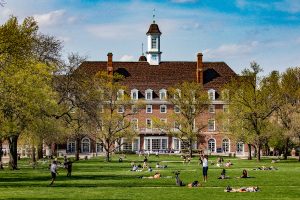College ag enrollments holding ground in Illinois
By Kay Shipman FarmWeek — September 28, 2021
SThe U of I, the College of Agricultural, Consumer and Environmental Sciences (ACES) saw increased enrollment in several student categories. (Photo courtesy of University of Illinois)
Agriculture study remains fruitful as students return in person to the four state universities with agricultural programs. With COVID mitigation guidelines in place, classroom space is at a premium on a couple of campuses.
This fall, agriculture programs continue within the same structures at Illinois State University, the University of Illinois and Western Illinois University. In Carbondale, agriculture is part of a restructured College of Agricultural, Life and Physical Sciences (CALPS) at Southern Illinois University.
Agriculture student enrollment held steady on Western Illinois University’s Macomb campus, said Andy Baker, the School of Agriculture director. Baker noted the freshman student enrollment grew to 74, but the school saw a decline in students transferring from community colleges or other institutions.
Campuswide, WIU maintained a stable enrollment of new students, including freshmen, transfer and graduate students, of 2,346. The total enrollment of 7,455 is nearly level with fall 2020 numbers.
“Our enrollment is stable, the kids are back in and I’m in. We’re having labs the way we want to have labs,” Baker said. “If the students have a chance to come in person, daily (class) attendance is up.”
In Normal, Illinois State University saw a slight decline in agriculture undergraduate students and an increase in ag graduate students, said Fanson Kidwaro, agriculture department chair.
In fact, ISU received a record number of applicants for agriculture graduate degrees. “We had 57 applicants (to grad school). We usually get 10 to 15,” Kidwaro said. Seventeen were admitted to the grad program.
At ISU, the three animal-related programs in pre-veterinary, animal science and animal industry continue to be strong, Kidwaro said, and agriculture business enrollment remains steady.
Campuswide, ISU experienced a 2 percent decrease in fall enrollment compared to 2020. The decline was attributed to several factors, including travel difficulties for international students and COVID-related impacts.
At the U of I, the College of Agricultural, Consumer and Environmental Sciences (ACES) saw increased enrollment in several student categories. A total of 2,820, undergraduates enrolled compared to 2,778 last fall. ACES registered more freshmen, 510, up from 478; more transfer students, 170, up from 162; and more graduate students, 757, up from 743.
A record number of freshmen, 8,303, are on the Urbana-Champaign campus, bringing total student enrollment to 56,299, the most in university history.
“Faculty and staff in ACES just keep saying how wonderful it is to have our students back. The whole place feels different than the last 18 months in all the best ways,” said Anna Ball, ACES associate dean of academic programs. “We’ve partnered closely with campus to keep students as safe as possible so they can focus on learning, growing, and enjoying their college experience.”
In Carbondale, Southern Illinois University agriculture programs saw a slight decrease overall with an undergraduate enrollment of 466 but an increase in graduate students with 87 enrolled. The ag program total enrollment is 553 students.
“We have some encouraging numbers this fall. Animal sciences and forestry numbers are particularly strong within our agricultural fields,” said Eric Brevik, CALPS dean. “It is wonderful to be able to meet with prospective students in person again. Events like the Farm Progress Show really allow us to reach out and recruit.”
Overall, fall CALPS enrollment was not available at presstime. However, SIU Carbondale registered a 4.5 percent increase in freshmen, the largest in the past five years. Overall, the campus enrollment of 11,266 is considered relatively flat with a 0.9 percent decline.
Each of the universities is addressing COVID mitigation guidelines on their respective campuses.
In Macomb and Normal, finding classrooms to accommodate students has been an added challenge given WIU and ISU requirements to space students apart, according to Baker and Kidwaro.
“It was a big chess match,” Baker said of professors seeking rooms across campus. One of the ag department’s classrooms that can seat 42 students is “heavily scheduled” by other programs, and an ag computer lab was converted into a classroom.
Kidwaro explained ISU ag professors and students are meeting in buildings not traditionally used by ag students. ISU’s system to track available classrooms that are large enough has helped, he said.
This story was distributed through a cooperative project between Illinois Farm Bureau and the Illinois Press Association. For more food and farming news, visit FarmWeekNow.com.







